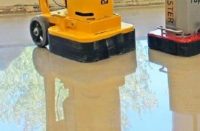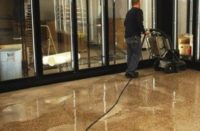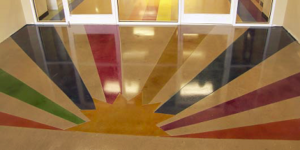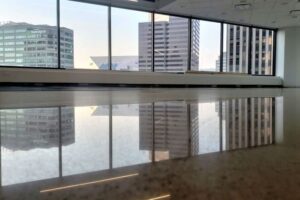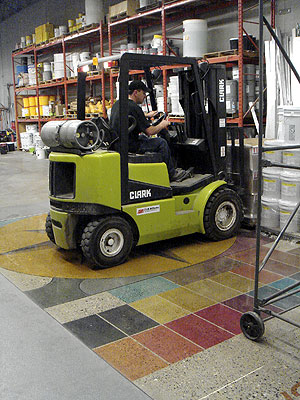 We’ve grown up, and now we have to act accordingly, and in unison, for our industry to reach its true potential. We all need to truly understand the process.
We’ve grown up, and now we have to act accordingly, and in unison, for our industry to reach its true potential. We all need to truly understand the process.
Let’s start with understanding densification and hardening for polished concrete.
Hardening and densifying are the chemical reactions that occur when the silicate or siliconate (whether lithium, potassium or sodium) interacts with the calcium hydroxide that is formed during cement hydration in the concrete-curing process. This chemical reaction produces a crystalline growth that not only hardens the concrete, but also tightens up the interior of the concrete floor. By hardening, we are referring to an increase in abrasion and impact resistance of the concrete. This process begins immediately upon product application, whereas the second component, densification, occurs more slowly as the internal crystallization is created. It is the internal densification that provides the increased repellency.
While this process does provide a stronger product, some will also point out that the grinding process that removes the cream, which has been highly consolidated during the hard-steel troweling process, lessens the tightness of the floor, thus lowering the natural repellency. Also, it can take four to six months to reach full repellency in densified concrete. This is one reason for applying an oil- and water-based stain repellant.
Potential stumbling blocks in polishing concrete: a list
Scratch patterns — Scratch patterns are the result of the diamonds passing over the concrete surface to remove material. Diamonds come in different grit sizes (similar to sandpaper) and different matrixes (metal, hybrids, resin and phenolic-based). The role of each successive diamond is to remove the scratch pattern left by the previous diamond. The ultimate clarity of the floor’s polish is determined by how well you remove laitance and irregularities with your first two diamond steps.
Also, a general rule is that you use soft matrix diamonds on hard concrete and hard matrix diamonds on soft concrete. This provides a more controlled release of the diamonds for cutting and polishing. Remember that no two slabs are identical.
Appearance — Your ability to provide a particular appearance in the final floor is influenced by the condition of the floor that you receive up front, along with the type of equipment and diamonds you are using. Make sure that you understand your capabilities and the customer’s expectations before committing to a project. For instance: edges and footings tend to be hand-troweled, not hard-steel-troweled, resulting in a softer, more porous surface, which generally results in a different surface appearance than the main floor. Additionally, if you are applying dyes or acid stains, they will generally absorb the colors differently.
Chemical barriers — Curing compounds and tilt-wall release agents, along with old mastics, can create barriers to the penetration of densifiers, dyes and acid stains. UV-dissipative curing agents and tilt-wall releases penetrate into the floor, thus blocking penetration of your product. In the past, a specifier only had to be concerned with the contractor’s ability to remove these barriers for surface coverings and coatings, and although chemical removal of these barriers may be successful if they are not too deep, often you will be required to grind the product out, often to a 40-grit metal level. Not only do these added steps increase the cost of the project, but they will also change the appearance by exposing more aggregate.
Pre-test requirements/specification knowledge — Polishing concrete is not as simple as baking cookies. Each batch of concrete can be different, even when the same mix is used on the same job and on the same day — there are too many factors to guarantee 100 percent consistency. Variations in mix design, water-cement ratios, temperature, admixtures, curing methods, humidity or finishing, or a change in personnel or equipment, can all make this a crapshoot. You need to be aware of what went into your slab before you begin your job on a full scale. The cost of “tuition” can be very high if you do not verify your work parameters on a test area first.
Construction protection/maintenance — Always discuss protection and maintenance with the owner, architect or general contractor. If they do not know your needs, then you have failed in your role as the expert, and you have opened up the opportunity for damage to occur to the floor that may be irreparable. Remember: No cutting oils; use nonmarking tires; diaper the equipment; keep the floor free from spills and dropped tools; keep the other trades off your work area. Recommend protection following completion with a product such as Easy Cover. Not only should you provide the end user with a recommended cleaner, you should also invest the time to help establish a maintenance program. You might even consider providing the maintenance. Polished concrete is not maintenance-free, but it should be a very high-performance floor with the proper maintenance.
Polished concrete started out as a functional product to fix spalling and dusting concrete, primarily on industrial floors. Expectations, along with choices, were limited, whereas today the sky is the limit. With polished concrete’s change from being purely functional to becoming design- and performance-oriented, a standard and preferred flooring option, comes the responsibility for the industry to grow in knowledge and professionalism. Move ahead into 2008 with the knowledge that you can be successful and profitable, but only if you invest the time, interest and money into education, and with that building a strong foundation for growth. Be proud of your work, let it reflect positively on you, your employee and your industry, and don’t forget to reinvest as you move forward.
